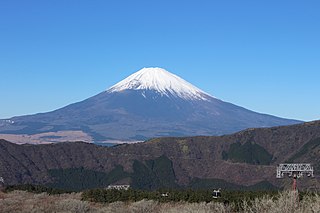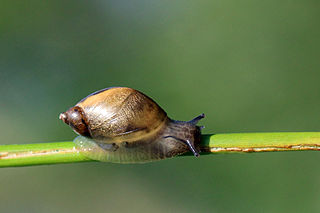
Mount Fuji is an active stratovolcano located on the Japanese island of Honshū, with a summit elevation of 3,776.24 m. It is the tallest mountain in Japan, the second-highest volcano located on an island in Asia, and seventh-highest peak of an island on Earth. Mount Fuji last erupted from 1707 to 1708. The mountain is located about 100 km (62 mi) southwest of Tokyo and is visible from the Japanese capital on clear days. Mount Fuji's exceptionally symmetrical cone, which is covered in snow for about five months of the year, is commonly used as a cultural icon of Japan and is frequently depicted in art and photography, as well as visited by sightseers, hikers and mountain climbers.

Yamanashi Prefecture is a prefecture of Japan located in the Chūbu region of Honshu. Yamanashi Prefecture has a population of 817,192 and has a geographic area of 4,465 km2. Yamanashi Prefecture borders Saitama Prefecture to the northeast, Nagano Prefecture to the northwest, Shizuoka Prefecture to the southwest, Kanagawa Prefecture to the southeast, and Tokyo to the east.

Minami Alps National Park is a national park in the Akaishi Mountains, Chūbu region, Honshū, Japan.

Leucochloridium paradoxum, the green-banded broodsac, is a parasitic flatworm. Its intermediate hosts are land snails, usually of the genus Succinea. The pulsating, green broodsacs fill the eye stalks of the snail, thereby attracting predation by birds, the primary host. These broodsacs visually imitate caterpillars, a prey of birds. The adult parasite lives in the bird's cloaca, releasing its eggs into the faeces.

Succinea, common name the amber snails, is a large genus of small, air-breathing land snails, terrestrial pulmonate gastropod molluscs in the family Succineidae.

Succinea putris is a species of small air-breathing land snail in the family Succineidae, the amber snails.

Chrysomyxa ledi var. rhododendri is a plant pathogen responsible for the disease spruce needle rust.

The Chittenango ovate amber snail is a species of small air-breathing land snail in the family Succineidae, the amber snails. This species was discovered in 1905, and was reported three years later as a subspecies of the oval ambersnail, Succinea ovalis. Several taxonomic reviews took place in the subsequent decades until the end of the 1980s, when the Chittenango ovate amber snail was finally judged to be a distinct species based on chemical and morphological data.

Succinea sanctaehelenae is a species of land snail in the family Succineidae, the amber snails. It is known commonly as the blushing snail. It is endemic to the island of Saint Helena in the South Atlantic Ocean.
Succinea concordialis, common name the spotted ambersnail, is a species of small, air-breathing, land snail, a terrestrial pulmonate gastropod mollusc in the family Succineidae, the amber snails.
Chaetorellia succinea is a species of tephritid fruit fly that was accidentally released in 1991 into the United States and had since become one of the major biological pest controls against the noxious weed yellow starthistle.

Neritilia succinea is a species of submarine cave snail, a marine gastropod mollusc in the family Neritiliidae.
Lacuna succinea is a species of sea snail, a marine gastropod mollusk in the family Littorinidae, the winkles or periwinkles.

Alitta succinea is a species of marine annelid in the family Nereididae. It has been recorded throughout the North West Atlantic, as well as in the Gulf of Maine and South Africa.

Chrysomyxa is a genus of rust fungi in the family Coleosporiaceae. The genus, widespread in the Northern Hemisphere, contains about 23 species. Rust fungi in the genus Chrysomyxa occur in boreal forests of the northern hemisphere on Pinaceae,, and most species alternate to angiosperm hosts in the Ericaceae.
Chrysomyxa abietis, or spruce needle rust, is a species of rust fungi in the Coleosporiaceae family that is native to eastern Europe and northern Asia. It was introduced to Australia, New Zealand and the United States.
Chrysomyxa himalensis, is a species of rust fungi in the Coleosporiaceae family that can be found on Rhododendron and Picea species in the Himalayan region of southern Asia and was introduced in the United States.
Chrysomyxa pyrolae, is a species of rust fungi in the family Coleosporiaceae that can be found in such US states such as Alabama, Colorado, Maine and Vermont.
Spruce broom rust or yellow witches' broom rust is a fungal plant disease caused by the basidiomycete fungus known as Chrysomyxa arctostaphyli. It occurs exclusively in North America, with the most concentrated outbreaks occurring in northern Arizona and southern Colorado on blue and Engelmann spruce, as well as in Alaska on black and white spruce. This disease alternates its life cycle between two hosts, with the spruce serving as the primary host and bearberry serving as the secondary or alternate host. The name for the disease comes from the distinctive “witches broom”, commonly yellow in color, which forms on the spruce after young needles have been infected. Management must be carried out through physical or mechanical methods, such as the pruning of brooms or the removal of the secondary host from the area, because no chemical control measures have yet been determined to be economically effective. Generally, spruce broom rust is seen as a mostly cosmetic issue, and it is very rarely the direct cause of tree death; however, research has shown a reduction in overall productivity and health of infected trees, making it an important issue for logging and timber companies.

Charidotella succinea is a species of tortoise beetle in the family Chrysomelidae. It is found in Central America and North America.










